Liang Peng
EmoFace: Emotion-Content Disentangled Speech-Driven 3D Talking Face with Mesh Attention
Aug 21, 2024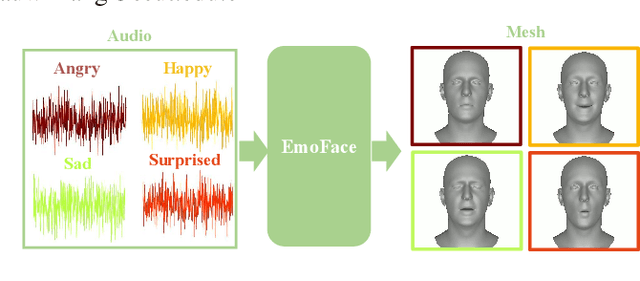
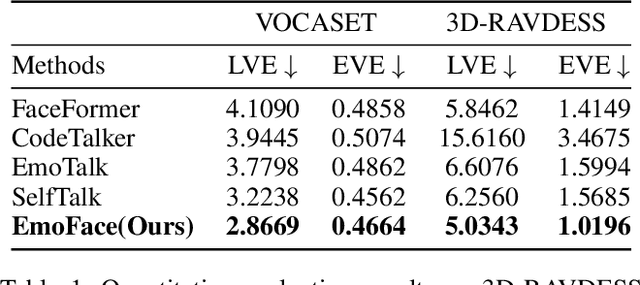
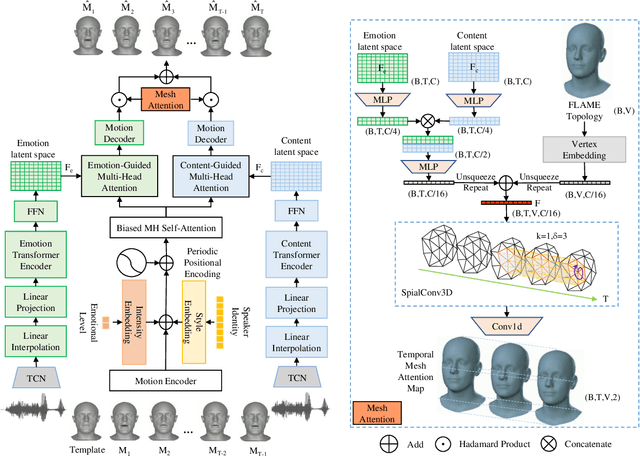

Abstract:The creation of increasingly vivid 3D virtual digital humans has become a hot topic in recent years. Currently, most speech-driven work focuses on training models to learn the relationship between phonemes and visemes to achieve more realistic lips. However, they fail to capture the correlations between emotions and facial expressions effectively. To solve this problem, we propose a new model, termed EmoFace. EmoFace employs a novel Mesh Attention mechanism, which helps to learn potential feature dependencies between mesh vertices in time and space. We also adopt, for the first time to our knowledge, an effective self-growing training scheme that combines teacher-forcing and scheduled sampling in a 3D face animation task. Additionally, since EmoFace is an autoregressive model, there is no requirement that the first frame of the training data must be a silent frame, which greatly reduces the data limitations and contributes to solve the current dilemma of insufficient datasets. Comprehensive quantitative and qualitative evaluations on our proposed high-quality reconstructed 3D emotional facial animation dataset, 3D-RAVDESS ($5.0343\times 10^{-5}$mm for LVE and $1.0196\times 10^{-5}$mm for EVE), and publicly available dataset VOCASET ($2.8669\times 10^{-5}$mm for LVE and $0.4664\times 10^{-5}$mm for EVE), demonstrate that our algorithm achieves state-of-the-art performance.
GLDiTalker: Speech-Driven 3D Facial Animation with Graph Latent Diffusion Transformer
Aug 03, 2024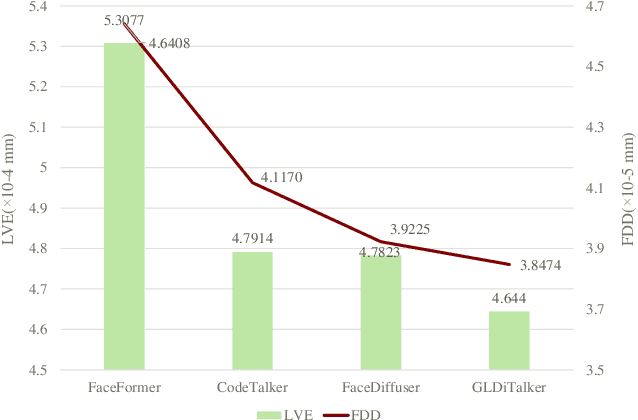

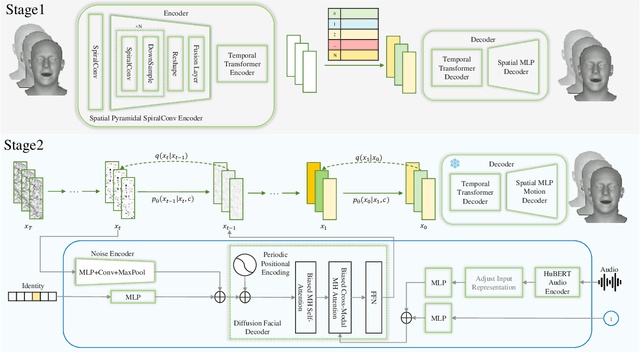
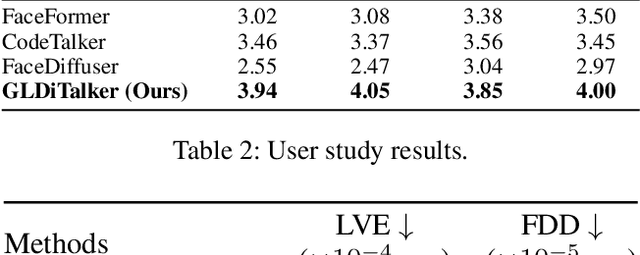
Abstract:3D speech-driven facial animation generation has received much attention in both industrial applications and academic research. Since the non-verbal facial cues that exist across the face in reality are non-deterministic, the generated results should be diverse. However, most recent methods are deterministic models that cannot learn a many-to-many mapping between audio and facial motion to generate diverse facial animations. To address this problem, we propose GLDiTalker, which introduces a motion prior along with some stochasticity to reduce the uncertainty of cross-modal mapping while increasing non-determinacy of the non-verbal facial cues that reside throughout the face. Particularly, GLDiTalker uses VQ-VAE to map facial motion mesh sequences into latent space in the first stage, and then iteratively adds and removes noise to the latent facial motion features in the second stage. In order to integrate different levels of spatial information, the Spatial Pyramidal SpiralConv Encoder is also designed to extract multi-scale features. Extensive qualitative and quantitative experiments demonstrate that our method achieves the state-of-the-art performance.
PD-TPE: Parallel Decoder with Text-guided Position Encoding for 3D Visual Grounding
Jul 19, 2024



Abstract:3D visual grounding aims to locate the target object mentioned by free-formed natural language descriptions in 3D point cloud scenes. Most previous work requires the encoder-decoder to simultaneously align the attribute information of the target object and its relational information with the surrounding environment across modalities. This causes the queries' attention to be dispersed, potentially leading to an excessive focus on points irrelevant to the input language descriptions. To alleviate these issues, we propose PD-TPE, a visual-language model with a double-branch decoder. The two branches perform proposal feature decoding and surrounding layout awareness in parallel. Since their attention maps are not influenced by each other, the queries focus on tokens relevant to each branch's specific objective. In particular, we design a novel Text-guided Position Encoding method, which differs between the two branches. In the main branch, the priori relies on the relative positions between tokens and predicted 3D boxes, which direct the model to pay more attention to tokens near the object; in the surrounding branch, it is guided by the similarity between visual and text features, so that the queries attend to tokens that can provide effective layout information. Extensive experiments demonstrate that we surpass the state-of-the-art on two widely adopted 3D visual grounding datasets, ScanRefer and NR3D, by 1.8% and 2.2%, respectively. Codes will be made publicly available.
Searching Priors Makes Text-to-Video Synthesis Better
Jun 05, 2024
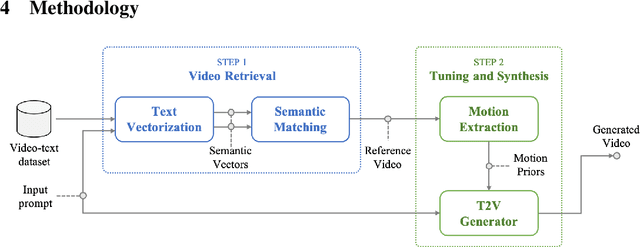

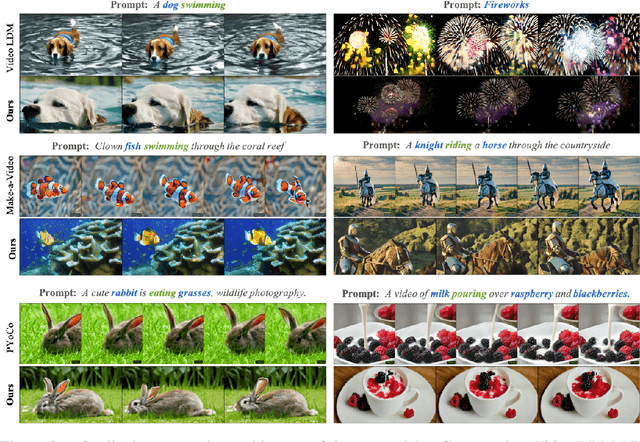
Abstract:Significant advancements in video diffusion models have brought substantial progress to the field of text-to-video (T2V) synthesis. However, existing T2V synthesis model struggle to accurately generate complex motion dynamics, leading to a reduction in video realism. One possible solution is to collect massive data and train the model on it, but this would be extremely expensive. To alleviate this problem, in this paper, we reformulate the typical T2V generation process as a search-based generation pipeline. Instead of scaling up the model training, we employ existing videos as the motion prior database. Specifically, we divide T2V generation process into two steps: (i) For a given prompt input, we search existing text-video datasets to find videos with text labels that closely match the prompt motions. We propose a tailored search algorithm that emphasizes object motion features. (ii) Retrieved videos are processed and distilled into motion priors to fine-tune a pre-trained base T2V model, followed by generating desired videos using input prompt. By utilizing the priors gleaned from the searched videos, we enhance the realism of the generated videos' motion. All operations can be finished on a single NVIDIA RTX 4090 GPU. We validate our method against state-of-the-art T2V models across diverse prompt inputs. The code will be public.
Modeling and simulation of a mechanism for suppressing the flipping problem of a jumping robot
May 20, 2024



Abstract:In order to solve the problem of stable jumping of micro robot, we design a special mechanism: elastic passive joint (EPJ). EPJ can assist in achieving smooth jumping through the opening-closing process when the robot jumps. First, we introduce the composition and operation principle of EPJ, and perform a dynamic modeling of the robot's jumping process. Then, in order to verify the effectiveness of EPJ in controlling the robot's smooth jump, we design a simulation experiment based on MATLAB. Through comparative experiments, it was proved that EPJ can greatly adjust the angular velocity of the robot and increase the jump distance of the robot. Finally, we analyze each parameter in EPJ and performs parameter optimization. After optimization, EPJ achieves a completely flip-free jump of the robot, laying an important foundation for improving the mobility of micro-robot.
Pseudo Label Refinery for Unsupervised Domain Adaptation on Cross-dataset 3D Object Detection
Apr 30, 2024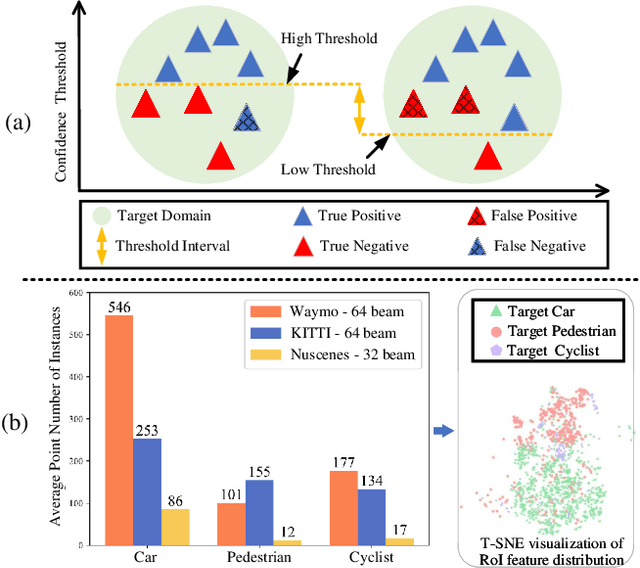
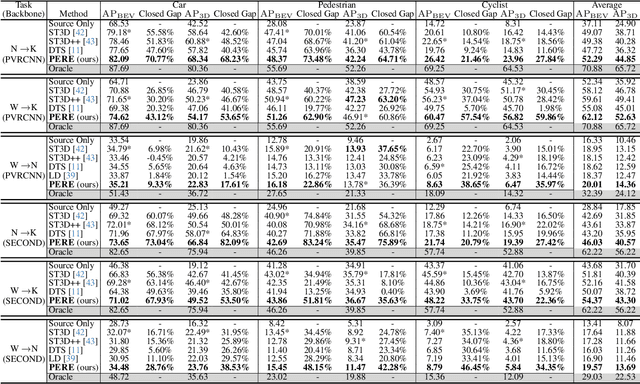
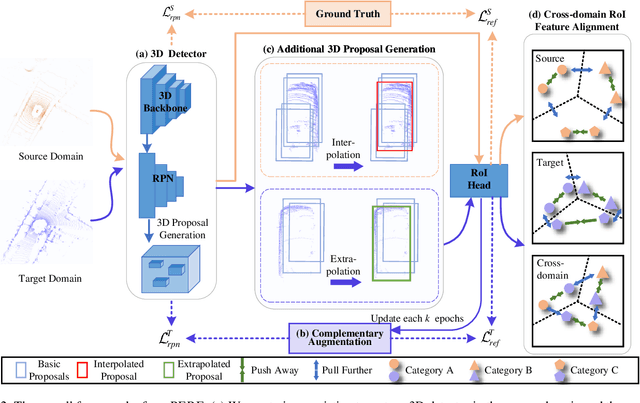

Abstract:Recent self-training techniques have shown notable improvements in unsupervised domain adaptation for 3D object detection (3D UDA). These techniques typically select pseudo labels, i.e., 3D boxes, to supervise models for the target domain. However, this selection process inevitably introduces unreliable 3D boxes, in which 3D points cannot be definitively assigned as foreground or background. Previous techniques mitigate this by reweighting these boxes as pseudo labels, but these boxes can still poison the training process. To resolve this problem, in this paper, we propose a novel pseudo label refinery framework. Specifically, in the selection process, to improve the reliability of pseudo boxes, we propose a complementary augmentation strategy. This strategy involves either removing all points within an unreliable box or replacing it with a high-confidence box. Moreover, the point numbers of instances in high-beam datasets are considerably higher than those in low-beam datasets, also degrading the quality of pseudo labels during the training process. We alleviate this issue by generating additional proposals and aligning RoI features across different domains. Experimental results demonstrate that our method effectively enhances the quality of pseudo labels and consistently surpasses the state-of-the-art methods on six autonomous driving benchmarks. Code will be available at https://github.com/Zhanwei-Z/PERE.
LoRA-Composer: Leveraging Low-Rank Adaptation for Multi-Concept Customization in Training-Free Diffusion Models
Mar 18, 2024Abstract:Customization generation techniques have significantly advanced the synthesis of specific concepts across varied contexts. Multi-concept customization emerges as the challenging task within this domain. Existing approaches often rely on training a Low-Rank Adaptations (LoRA) fusion matrix of multiple LoRA to merge various concepts into a single image. However, we identify this straightforward method faces two major challenges: 1) concept confusion, which occurs when the model cannot preserve distinct individual characteristics, and 2) concept vanishing, where the model fails to generate the intended subjects. To address these issues, we introduce LoRA-Composer, a training-free framework designed for seamlessly integrating multiple LoRAs, thereby enhancing the harmony among different concepts within generated images. LoRA-Composer addresses concept vanishing through Concept Injection Constraints, enhancing concept visibility via an expanded cross-attention mechanism. To combat concept confusion, Concept Isolation Constraints are introduced, refining the self-attention computation. Furthermore, Latent Re-initialization is proposed to effectively stimulate concept-specific latent within designated regions. Our extensive testing showcases a notable enhancement in LoRA-Composer's performance compared to standard baselines, especially when eliminating the image-based conditions like canny edge or pose estimations. Code is released at https://github.com/Young98CN/LoRA\_Composer.
VastTrack: Vast Category Visual Object Tracking
Mar 06, 2024Abstract:In this paper, we introduce a novel benchmark, dubbed VastTrack, towards facilitating the development of more general visual tracking via encompassing abundant classes and videos. VastTrack possesses several attractive properties: (1) Vast Object Category. In particular, it covers target objects from 2,115 classes, largely surpassing object categories of existing popular benchmarks (e.g., GOT-10k with 563 classes and LaSOT with 70 categories). With such vast object classes, we expect to learn more general object tracking. (2) Larger scale. Compared with current benchmarks, VastTrack offers 50,610 sequences with 4.2 million frames, which makes it to date the largest benchmark regarding the number of videos, and thus could benefit training even more powerful visual trackers in the deep learning era. (3) Rich Annotation. Besides conventional bounding box annotations, VastTrack also provides linguistic descriptions for the videos. The rich annotations of VastTrack enables development of both the vision-only and the vision-language tracking. To ensure precise annotation, all videos are manually labeled with multiple rounds of careful inspection and refinement. To understand performance of existing trackers and to provide baselines for future comparison, we extensively assess 25 representative trackers. The results, not surprisingly, show significant drops compared to those on current datasets due to lack of abundant categories and videos from diverse scenarios for training, and more efforts are required to improve general tracking. Our VastTrack and all the evaluation results will be made publicly available https://github.com/HengLan/VastTrack.
MMGPL: Multimodal Medical Data Analysis with Graph Prompt Learning
Dec 22, 2023Abstract:Prompt learning has demonstrated impressive efficacy in the fine-tuning of multimodal large models to a wide range of downstream tasks. Nonetheless, applying existing prompt learning methods for the diagnosis of neurological disorder still suffers from two issues: (i) existing methods typically treat all patches equally, despite the fact that only a small number of patches in neuroimaging are relevant to the disease, and (ii) they ignore the structural information inherent in the brain connection network which is crucial for understanding and diagnosing neurological disorders. To tackle these issues, we introduce a novel prompt learning model by learning graph prompts during the fine-tuning process of multimodal large models for diagnosing neurological disorders. Specifically, we first leverage GPT-4 to obtain relevant disease concepts and compute semantic similarity between these concepts and all patches. Secondly, we reduce the weight of irrelevant patches according to the semantic similarity between each patch and disease-related concepts. Moreover, we construct a graph among tokens based on these concepts and employ a graph convolutional network layer to extract the structural information of the graph, which is used to prompt the pre-trained multimodal large models for diagnosing neurological disorders. Extensive experiments demonstrate that our method achieves superior performance for neurological disorder diagnosis compared with state-of-the-art methods and validated by clinicians.
Regulating Intermediate 3D Features for Vision-Centric Autonomous Driving
Dec 19, 2023Abstract:Multi-camera perception tasks have gained significant attention in the field of autonomous driving. However, existing frameworks based on Lift-Splat-Shoot (LSS) in the multi-camera setting cannot produce suitable dense 3D features due to the projection nature and uncontrollable densification process. To resolve this problem, we propose to regulate intermediate dense 3D features with the help of volume rendering. Specifically, we employ volume rendering to process the dense 3D features to obtain corresponding 2D features (e.g., depth maps, semantic maps), which are supervised by associated labels in the training. This manner regulates the generation of dense 3D features on the feature level, providing appropriate dense and unified features for multiple perception tasks. Therefore, our approach is termed Vampire, stands for "Volume rendering As Multi-camera Perception Intermediate feature REgulator". Experimental results on the Occ3D and nuScenes datasets demonstrate that Vampire facilitates fine-grained and appropriate extraction of dense 3D features, and is competitive with existing SOTA methods across diverse downstream perception tasks like 3D occupancy prediction, LiDAR segmentation and 3D objection detection, while utilizing moderate GPU resources. We provide a video demonstration in the supplementary materials and Codes are available at github.com/cskkxjk/Vampire.
 Add to Chrome
Add to Chrome Add to Firefox
Add to Firefox Add to Edge
Add to Edge